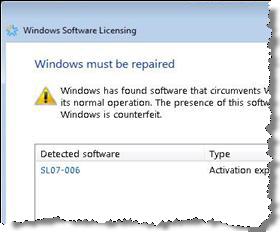Microsoft removes another one of WGA's fangs


Now-departed Microsoft marketing chief Michael Sievert announced last December that Service Pack 1 would drop Vista’s “reduced functionality mode” (the notorious “kill switch”) in favor of a series of notifications and nag screens. WGA senior product manager Alex Kochis posted the details of today’s changes, with screen shots, on Microsoft’s Windows Genuine Advantage blog today.
The new WGA code in SP1 is designed to detect two of the most common activation cracks: one tries to fool Vista into thinking that it’s an OEM; the other fools the activation timer into waiting until some far-off date in the future. Later this month, before SP1 begins rolling out, Microsoft plans to deliver a Vista update that checks for the presence of those two specific cracks. Unlike XP’s WGA add-in, which was designed to confirm that the system’s activation was valid and wound up failing too often, this one looks only for the details of those two hacks. If it finds the “signature,” it displays the message shown here:
It's worth noting that this first release of the crack-detecting update won't try to remove the crack or shut down the computer; Kochis says the detection and removal functions will be combined in the next release, with no date announced for that. In the upcoming version of this update, links on the informational dialog box will lead to webpages with repair details, but you can dismiss the dialog box immediately - and permanently, if you choose. Anyone who sought out and used one of these two hacks to avoid paying for a legitimate copy of Windows will probably not be surprised. (They can also use a different activation hack that Microsoft hasn't yet written detection code for.) In addition to those unrepentant pirates, however, Microsoft believes there are a significant number of technically unsophisticated customers who had their system upgraded by a friend or a shady repair shop and have no idea that it’s been hacked. For them, the new update is designed to serve as an early warning that they’ll have to deal with product activation sooner or later.
The change in product activation kicks in whenever Windows decides that your system’s activation status is no longer “genuine” – a state of affairs that can come about if you fail to activate within the original 30–day grace period, or if the WGA validation code detects that your system has been tampered with, or if it appears based on hardware changes that the activated copy has been moved to another computer. In either of the latter two cases, activation is revoked and a three-day grace timer begins.
Previously, with both Windows XP and Windows Vista, the end of the grace period meant you had to activate, period. If you let the clock run out without activating over the Internet or by phone, Windows refused to run. With Vista SP1, you’ll see the dialog box shown here, which goes away after 15 seconds. If you’re not ready, willing, or able to deal with Microsoft’s phone activation line, you get to log in and use every Windows feature after the 15–second period has passed. In theory, a Windows user who doesn’t mind the nag screens can run an unactivated copy of Vista indefinitely.
The big question at this point is whether these changes have been properly tested and whether they’ll have any unintended side effects. (The current problems with one of the prerequisite updates for SP1 don’t inspire a lot of confidence in the Windows Update process.) Although this update looks small in scope, it’s still possible that it will result in false positives like last summer’s server-side glitch that flagged a bunch of genuine customers as pirates. A lot of people will be watching over the next couple months to see if Microsoft follows through on its promise to “build more trust in WGA”. With the recent round of changes, WGA certainly hasn't been rendered toothless. But its bite is now far less painful.
Note: an early draft of this story appeared briefly (for 10-15 minutes) on this site before the final version was posted.